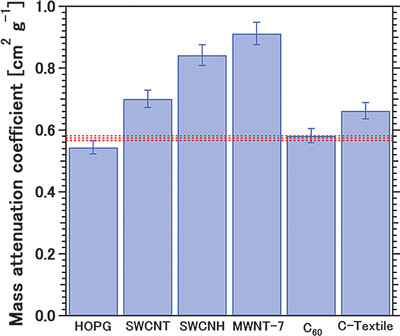| Posted: Jan 16, 2012 | |
Enhanced X-ray shielding with carbon nanotubes |
|
| (Nanowerk Spotlight) Theoretical and experimental studies over the past few years have demonstrated that carbon nanotubes (CNTs) could exhibit novel and outstanding electromagnetic effects. Researchers have used this to fabricate various types of CNT nanocomposite materials for electromagnetic interference shielding, outperforming conventional shielding (see for instance: "Breakthrough nanocomposite material has virtues of plastics and metals"). In new work, scientists have now demonstrated the enhanced X-ray shielding of CNTs (see paper in Materials Express: "Enhanced X-Ray Shielding Effects of Carbon Nanotubes"). | |
| "The mechanism for our observations is still far from clear elucidation and it cannot be understood by conventional X-ray attenuation theory," Shuji Tsuruoka, a researcher at Shinshu University's Research Center for Exotic NanoCarbons, and one of the paper's authors, tells Nanowerk. | |
| Previously, scientists believed that X-ray attenuation – the gradual loss in intensity of X-rays as they travel through a medium (for instance lead) – was determined by the atomic number of a material and that its structure didn't matter. What the team found, though, was that that the mass attenuation coefficient of CNTs was by 20–50% higher than that observed for highly oriented pyrolytic graphite (HOPG) and fullerenes. | |
| "We found that the attenuation coefficient of CNTs increased by reducing the sample thickness" says Tsuruoka. "This attenuation phenomenon indicates the importance of the unique nanoscale morphology of CNTs, which cannot be interpreted by the already established X-ray absorption theory." | |
| Although they cannot explain the observed enhanced X-ray attenuation properties of CNTs as yet, the researchers assume that the unusually high shielding effect of CNTs is likely to originate from their unique cylindrical nano-morphology. | |
 |
|
| Mass attenuation coefficients of different carbon materials. The incident X-ray beam was monochromatic MoKα (λ = 0.7107Å) at 50 kV and 10 mA. Width of the horizontal red belt shows the graphite mass attenuation coefficient in the literature; those attenuation coefficients for pure graphite are 0.566, 0.576 and 0.581 cm2 g-1. (Reprinted with permission from American Scientific Publishers) | |
| For their X-ray attenuation experiments, Tsuruoka and his collaborators used single- and multi-walled CNTs, single-wall carbon nanohorns, fullerenes (C60), graphene oxide, and a fabric-textile coated with multi-walled CNTs. They found that all these materials, except fullerenes, had higher mass attenuation coefficients than HOPG. | |
| "We noted that the mass attenuation coefficient of fullerenes was almost equivalent to HOPG, but that the cylindrically rolled graphene structures, the nanotubes, increased the X-ray attenuation significantly," says Tsuruoka. "This phenomenon does not follow any conventional rule stating that the mass attenuation coefficients are inherent to the type of elements contained within the material." | |
| By coating textile fibers with multi-walled CNTs, the researchers were able to transfer the unusually high attenuation property of the CNTs to the textile. The attenuation percentage rapidly increases by increasing the fabric thickness, reaching an attenuation percentage higher than 70% with 24 mm thick films. | |
| According to Tsuruoka, these results are potentially opening new avenues for fabricating lightweight fabrics able to offer protection against X-ray radiation and provided much lighter in-use-weight in comparison with the current lead and/or the other heavy metal base equipment. It also might accelerate fundamental studies with regard to applying carbon nanotubes to stealth applications. | |
| "However, we need to conduct further fundamental research in order to elucidate the enhancement mechanism of X-ray attenuation behind our observations" he says. | |
 By
Michael
Berger
– Michael is author of three books by the Royal Society of Chemistry:
Nano-Society: Pushing the Boundaries of Technology,
Nanotechnology: The Future is Tiny, and
Nanoengineering: The Skills and Tools Making Technology Invisible
Copyright ©
Nanowerk LLC
By
Michael
Berger
– Michael is author of three books by the Royal Society of Chemistry:
Nano-Society: Pushing the Boundaries of Technology,
Nanotechnology: The Future is Tiny, and
Nanoengineering: The Skills and Tools Making Technology Invisible
Copyright ©
Nanowerk LLC
|
|
|
Become a Spotlight guest author! Join our large and growing group of guest contributors. Have you just published a scientific paper or have other exciting developments to share with the nanotechnology community? Here is how to publish on nanowerk.com. |
|
